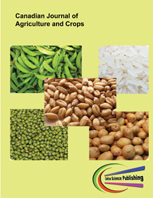Evaluating the Potential Effect of Foliar Fertilizers on Cowpea Growth and Yield
DOI:
https://doi.org/10.20448/803.4.2.144.152Keywords:
Biomass, Fertilization, Folia, Growth, Legume, Mobilization, Volatilization.Abstract
A experiment to evaluate performance of foliar fertilizers on cowpea growth and yield was conducted in the 2015/16 Zimbabwean summer season. This experiment was laid out in a randomized complete block design with 4 replications. Treatments were; a control (no fertilizer), 300 kg/ha compound D only, 300 kg/ha compound D + foliar fertilizers, 150 kg/ha compound D + foliar fertilizers and foliar fertilizers only. Leaf number, branch number, pod number, biomass, pod weight and grain weight were measured. Application of foliar fertilizers had a significant (p < 0.05) effect on growth by increasing the leaf number per plant at 5 weeks after planting. Leaf number was in the order of 112.05 (300 kg/ha compound D + foliar fertilizers)>104.8 (300kg/ha compound D only) >84.55 (150 kg/ha compound D + foliar fertilizers >76.6 (control)> 73.95 (foliar fertilizers only). Foliar fertilizer application also had a significant (p < 0.05) effect on pod number. A combination of compound D + foliar fertilizers had the highest pod number 29.55 followed by compound D (26.72) and the least was from control (16.9). Grain yield of compound D + foliar fertilizers (0.35) was not statistically different from that of compound D only (0.32), but both were significantly (p < 0.05) different from the other treatments. Results showed that the effect of foliar fertilizers is most attributed if used in combination with compound D (basal fertilizer). There is need for further research to investigate if residual soil fertility can affect the yield of cowpea concerning the foliar applications.


